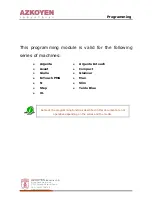
9
3.5 Thread tensioners and limiter
3.5.1 Description
The main tensioner (1) serves for creating the tension of the threads
when tightening the stitch. The auxiliary tensioner (2) reduces the risk
of pulling out of the thread after the thread trimming when removing
the sewn material, when the thread is passed through this material and
when the main tensioner is relieved. The main tensioner is relieved by
the mechanism controlled by the shaft of the presser foot lifting (3), on
which the lever (4), is mounted which shifts the prop (5), which pushes
the metal sheet lever (6). This lever shifts the pin (7) and this pin
pushes onto the washer (8) and relieves the spring (9).
With the machines provided with a thread trimming device, the main
tensioner (1) is relieved as well when switching on the electromag-
net (10), when its armature (11) pushes against the lever (6). The
mechanism of the adapting spring (12) maintains the thread in its
tensioned state when passing through the hook. The thread limiter
(13) limits the length of the thread fed by the take-up lever when
moving from the upper to the bottom dead centre to get a controlled
passing of the thread through the hook.
3.5.2 Setting the tension of the main and auxiliary
tensioners
The tension of the main thread tensioner is regulated by means of the
nut (1). The force of tensioning the thread is measured by the
dynamometer (2) as it is shown on the illustration. The size of this
force differs according to the category of sewing and is indicated in the
par. 11.2.
The tension of the auxiliary tensioner is regulated using the nut (3). It
should be the least possible, but sufficient for unthreading the thread
from the sewn material when removing the sewn material from the
pressing element without leaving the tensioner.
3.5.3 Setting the tensioning mechanism of
the main tensioners
The nut (1) must be screwed off in such a way that the metal sheet lever
(2) bears on the plate (3) and, at the same time, the lever (4) is not
limited by the prop (5) in its rotation. The lever (4) must be fixed
against the shaft (6) in such a way that, when the presser foot is in its
lowest position, the nut (1) bears on the metal sheet lever (2) with its
minimum clearance.
Caution ! Danger of injury!
Switch off the main switch! Before starting the setting
operation, wait until the motor stops!
- Unscrew thoroughly the nuts (7) and loosen the screw (8).
- Put in one line the axis of the shaft (6), the axis (9) and the axis of the
spherical surface of the nut (1).
- Unscrew the nut (1), until the metal sheet lever (2) strikes against the
plate (3). However, the lever (4) must rotate freely in the sense of the
arrows in both senses.
- Screw in the nuts (7) almost to the stop.
- Remove the sewn material and lower the presser foot.
- Turn the lever (4) in the sense of the arrow up to the stop.
- Return the lever (4) a bit back and tighten the screw (8).
6
8
3
1
7
2
5
9
4
6
8
2
4
1
7
P
3
1
2
P
3
2 1
4 5
7
6 11 8
9
2
1
13
12
10













































